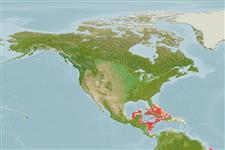Klassifizierung / Names
Namen | Synonyme | Catalog of Fishes(Gattung, Arten) | ITIS | CoL | WoRMS | Cloffa
>
Gobiiformes (Gobies) >
Gobiidae (Gobies) > Gobiinae
Etymology: Paedovaricus: Name from the root word ‘paed-’ (English spelling of the Greek root ‘ped-’, meaning ‘child’), combined with Varicus, referring to the small size of the type species and its general similarity to the genus Varicus..
More on author: Greenfield.
Environment: milieu / climate zone / depth range / distribution range
Ökologie
seewasser demersal; tiefenbereich 15 - 91 m (Ref. 92840). Tropical
Western Atlantic: Eleuthera Islands, Bahamas; Carrie Bow Cay, Belize.
Size / Gewicht / Alter
Maturity: Lm ? range ? - ? cm
Max length : 1.4 cm SL Männchen/unbestimmt; (Ref. 92840)
Kurzbeschreibung
Morphologie | Morphometrie
Rückenflossenstacheln (insgesamt): 8; Rückenflossenweichstrahlen (insgesamt): 7; Afterflossenstacheln 1; Afterflossenweichstrahlen: 7; Wirbelzahl: 27. Distinguished by the following characters: possesses all taxonomic characters present in most members of Gobiosomatini and Gobiosoma group (D1 VII, pterygiophore insertion pattern of 3-221110, vertebrae 27 with precaudal 11 and caudal 16, hypurals 1 and are 2 fused to some extent with hypurals 3 and 4 and the terminal vertebral element, 1 epural); pelvic fins are well separated, without both anterior frenum and well-developed membrane connecting innermost rays; pelvic-fin rays 1-5 unbranched, no flattened or fleshy tips; pelvic-fin rays very long, fourth ray extend posteriorly to origin of last anal-fin ray or beyond; scales on body (modified basicaudal scales present); an anal-fin pterygiophore inserted before first haemal spine, no cephalic lateralis canals and pores; D2 I,7; A I,7;body, head, and fins have a light yellowish orange hue, with diffuse dark vertical bars alongside of body, and very dark wide vertical band over posterior end of caudal peduncle and on the base of the caudal rays (Ref. 113825).
Rare in collections that little is known about the distribution and ecology (Ref. 92840).
Life cycle and mating behavior
Geschlechtsreife | Fortpflanzung | Ablaichen | Eier | Fecundity | Larven
Smith, C.L., 1997. National Audubon Society field guide to tropical marine fishes of the Caribbean, the Gulf of Mexico, Florida, the Bahamas, and Bermuda. Alfred A. Knopf, Inc., New York. 720 p. (Ref. 26938)
IUCN Rote Liste Status (Ref. 130435)
Bedrohung für Menschen
Harmless
Nutzung durch Menschen
Mehr Information
NamenSynonymeMetabolismusRäuberÖkotoxikologieFortpflanzungGeschlechtsreifeAblaichenSpawning aggregationFecundityEierEientwicklung
Alter/GrößeWachstumLänge-GewichtLänge-LängeLängenhäufigkeitenMorphometrieMorphologieLarvenLarven Pop.Dyn.RekrutierungDichteBRUVS
ReferenzenAquakulturAquakultur ProfilZuchtlinienGenetikElectrophoresesVererbbarkeitKrankheitenVerarbeitungNutrientsMass conversion
PartnerBilderStamps, Coins Misc.LauteCiguateraGeschwindigkeitSchwimmstilKiemenoberflächeOtolithsGehirngrößeSehfähigkeit
Tools
Zusatzinformationen
Download XML
Internet Quellen
Estimates based on models
Preferred temperature (Ref.
123201): 23.6 - 27.6, mean 25.7 °C (based on 47 cells).
Phylogenetic diversity index (Ref.
82804): PD
50 = 1.0000 [Uniqueness, from 0.5 = low to 2.0 = high].
Bayesian length-weight: a=0.00708 (0.00333 - 0.01504), b=3.09 (2.92 - 3.26), in cm total length, based on LWR estimates for this (Sub)family-body shape (Ref.
93245).
Trophic level (Ref.
69278): 3.0 ±0.3 se; based on size and trophs of closest relatives
Widerstandsfähigkeit (Ref.
120179): hoch, Verdopplung der Population dauert weniger als 15 Monate. (Preliminary K or Fecundity.).
Fishing Vulnerability (Ref.
59153): Low vulnerability (10 of 100).
